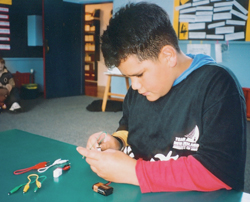Sampling general education schools
At year 8 level, 120 schools were selected randomly from national
lists of state, integrated and private schools teaching at that level,
with their probability of selection proportional to the number of
students enrolled in the level. The process used ensured that each
region was fairly represented. Schools with fewer than four students
enrolled at the given level were excluded from these main samples,
as were special schools and Mäori immersion schools (such as
Kura Kaupapa Mäori).
 |
 |
|
Sampling
Mäori immersion schools
Ten
schools were selected randomly from Mäori immersion schools (such
as Kura Kaupapa Mäori) that had at least 4 year 8 students, and
from other schools that had at least 4 year 8 students in classes
classified as Level 1 immersion (80 to 100 percent of instruction
taking place in Mäori). Six of the chosen schools were immersion
schools and four were general education schools with immersion classes
(reflecting the similar numbers of students nationally in the two
types of programme).
Pairing small schools
Nine of the 120 chosen schools in the general education sample had
less than 12 year 8 students. For each of these schools, we identified
the nearest small school meeting our criteria to be paired with the
first school. Wherever possible, schools with 8 to 11 students were
paired with schools with 4 to 7 students, and vice versa. However,
the travelling distances between the schools were also taken into
account. Six of the 10 schools in the Mäori immersion sample
also needed to be paired with other schools of the same type.
Contacting schools
In telephone calls with the principals, we briefly explained the purpose
of national monitoring, the safeguards for schools and students, and
the practical demands that participation would make on schools and
students. We informed the principals about the materials which would
be arriving in the school (a copy of a 20 minute NEMP videotape plus
copies for all staff and trustees of the general NEMP brochure and
the information booklet for sample schools). We asked the principals
to consult with their staff and Board of Trustees and confirm their
participation. Similar procedures were followed with the principals
of the 16 schools in the Mäori immersion sample, but for them
brochures in both Mäori and English were sent. Two of the immersion
schools, involving 16 students, withdrew from the assessments because
of other commitments, too late for substitutions to be arranged.
Sampling of students
With their confirmation of participation, each school sent a list
of the names of all year 8 students on their roll. Using computer
generated random numbers, we randomly selected the required number
of students (12, or 4 plus 8 in a pair of small schools), at the same
time clustering them into random groups of four students (which would
be allocated different sets of assessment tasks). The schools were
then sent a list of their selected students and invited to inform
us if special care would be needed in assessing any of those students
(e.g. students with disabilities or new settlers in New Zealand with
very limited skills in English). Where necessary, replacement students
were chosen, using the same random sampling procedure. Students in
Mäori immersion programmes were excluded if they had not passed
four years in Mäori immersion. Less than two percent of students
were replaced for reasons other than moving school or planned absence
for the full assessment week.
Communication with parents
Following these discussions with the school, Project staff prepared
letters to all of the parents, including a copy of the NEMP brochure,
and asked the schools to address the letters and mail them. Parents
were told they could obtain further information from Project staff
(using an 0800 number) or their school principal, and advised that
they had the right to ask that their child be excluded from the assessment.
Less than one percent of the selected students were replaced because
they or their parents declined to participate.
Practical arrangement with schools
On the basis of preferences expressed by the schools, we then allocated
each school to one of the five assessment weeks available and gave
them contact information for the two teachers who would come to the
school for a week to conduct the assessments. We also provided information
about the assessment schedule and the space and furniture requirements,
offering to pay for hire of a nearby facility if the school was too
crowded to accommodate the assessment programme.
Resulting samples
For the purposes of this report, we were interested in four groups
of year 8 students:
